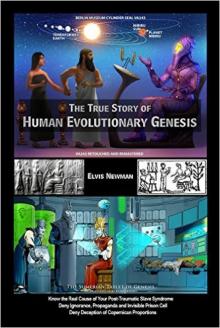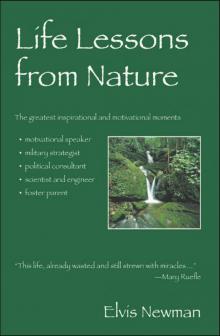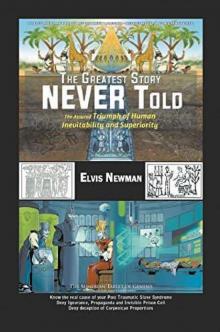- Home
- Elvis Newman
True Story of Human Evolutionary Genesis Page 3
True Story of Human Evolutionary Genesis Read online
Page 3
14
Chapter Seven
Ningishzidda’s Junk DNA and Abnormalities
Another try. Another deformed creature was made.
It was very late, and everyone had left the laboratory except
Ningishzidda. In daytime, the street was dusty from excavations in
the mines, but at night the dust and dew settled. Now at night, it
was quiet, and he could think alone. While he was brilliant in his
field, the enigma of life was to him still the greatest mystery. Only
the moon kept him company.
Another try. Another deformed creature was made.
Several weeks later, Ningishzidda again stayed back after every-
one had left the laboratory. “Junk DNA sequence. Maybe the junk
DNA sequence is the problem.” He kept trying and trying, until his
15
Elvis Newman
eyes could not tell all the junk DNA materials from the junk garbage. And he fell asleep at the table.
Another try. Another deformed creature was made.
Like a trial, you don’t have to be there to know the verdict.
Ningishzidda knew all the time what it would be. Still, Ningishzidda
tried again.
Another try. Another deformed creature was made.
Footnote
4,000 defects in the human genome
4,000 defects in the human genome are carried in everyone’s
DNA, more than any other species and they unnaturally survived
in the human gene pool instead of bred out. Over 4000 human dis-
eases are caused by single gene defects. Single gene disorders can
be passed on to subsequent generations in several ways.
Source: https://en.wikipedia.org/wiki/Genetic_disorder
Humans have only twenty-three pairs of chromosomes. All members of Hominidae except humans have twenty-four pairs of chromosomes. Humans have only twenty-three pairs of chromo- somes. Human chromosome 2 is widely accepted to be a result of an end-to-end fusion of two ancestral chromosomes. The evidence for this includes:
•The correspondence of chromosome 2 to two ape chro- mosomes. The closest human relative, the chimpanzee, has near-identical DNA sequences to human chromo- some 2, but they are found in two separate chromo- somes. The same is true of the more distant gorilla and orangutan.
•The presence of a vestigial centromere. Normally, a chro- mosome has just one centromere, but in chromosome 2, there are remnants of a second centromere.
•The presence of vestigial telomeres. These are normally found only at the ends of a chromosome, but in chromo- some 2, there are additional telomere sequences in the middle.
Chromosome two presents very strong evidence in favour of the common descent of humans and other apes. According to researcher J. W. IJdo, “We conclude that the locus cloned in cosmids c8.1 and c29B is the relic of an ancient telomere-telomere fusion and marks
16
The True Story of Human Evolutionary Genesis
the point at which two ancestral ape chromosomes fused to give rise to human chromosome 2.”
Source: https://en.wikipedia.org/wiki/Chromosome_2_(human)
Robertsonian Translocations
“People with Robertsonian translocations have only forty-five chromosomes in each of their cells, yet all essential genetic mate- rial is present, and they appear normal. Their children, however, may either be normal and carry the fusion chromosome (depend- ing which chromosome is represented in the gamete), or they may inherit a missing or extra long arm of an acrocentric chromo- some.” Kenneth F. Trofatter, Jr., MD, PhD
The common chimp (Pan troglodytes) and human Y chromo- somes The common chimp (Pan troglodytes) and human Y chro- mosomes are “horrendously different from each other,” says David Page of the Whitehead Institute for Biomedical Research in
Cambridge, Massachusetts, who led the work. “If you’re marching along the human chromosome 21, you might as well be marching along the chimp chromosome 21. It’s like an unbroken piece of glass,” says Page. “But the relationship between the human and chimp Y chromosomes has been blown to pieces.”
17
Chapter Eight
Curiosity Killed the Anunnaki
Brainstorming sessions after brainstorming sessions were held.
At length, a strange idea came about.
Enki related the fact to Nimah:
“Perhaps the admixture is not wrong. Maybe we need trace el-
ements, nanolife substances that were indigenous to earth. They
might play a very important role in the functioning and formation
of life. We can simulate a life-sustaining indigenous admixture from
the clay of earth. It would serve as a better primordial soup. We
should not stick to the conventional thinking of working with test
tubes produced by Nibiru factories. Nor should we set up labora-
tory conditions similar to Nibiru. We must observe biological, chem-
ical, and physical principles interacting here on Earth.”
“Then the LORD God formed man of dust from the ground”
(Genesis 2:7)
18
Chapter Nine
FOXP2 Language Gene
Terran Experiment No. 478,911
Nimah made a vessel using Africa’s clay. This she made into a pri- mordial soup. In the clay vessel, the fertilized Homo erectus’s ova, Anunnaki gene splices, and mitochondria extracts were carefully adjusted to the right proportions. Nimah then inserted the fertilized egg back into the female Homo erectus.
There was conception. A newborn at the awaited time was forth- coming.
It was a male. It was the image of perfection.
The leaders, Ningishzidda, Ninmah, and Enki were overjoyed.
Ningishzidda and Enki were backslapping the baby to make him
cry, thereby setting the precedent for all human doctors to follow.
The child was growing faster than on their home planet Nibiru.
His limbs were suited for a worker. However, he knew not speech.
He could only make grunts and snorts.
He had the chromosomal disorder FOXP2 and was unable to se-
lect and produce the fine movements with the tongue and lips that
were necessary to speak clearly.
The FOXP2 language gene was further investigated and then
spliced onto the hybrid’s chromosome.
Footnote
In humans, mutations of FOXP2 cause a severe speech and lan- guage disorder (Lai CSL, Fisher SE, Hurst JA, Vargha-Khadem F. Monaco AP (2001). “A forkhead-domain gene is mutated in a severe speech and language disorder.” Nature 413 (6855): 519-23
19
Contact the author
[email protected]

 True Story of Human Evolutionary Genesis
True Story of Human Evolutionary Genesis Life Lessons from Nature
Life Lessons from Nature The Greatest Story NEVER Told
The Greatest Story NEVER Told